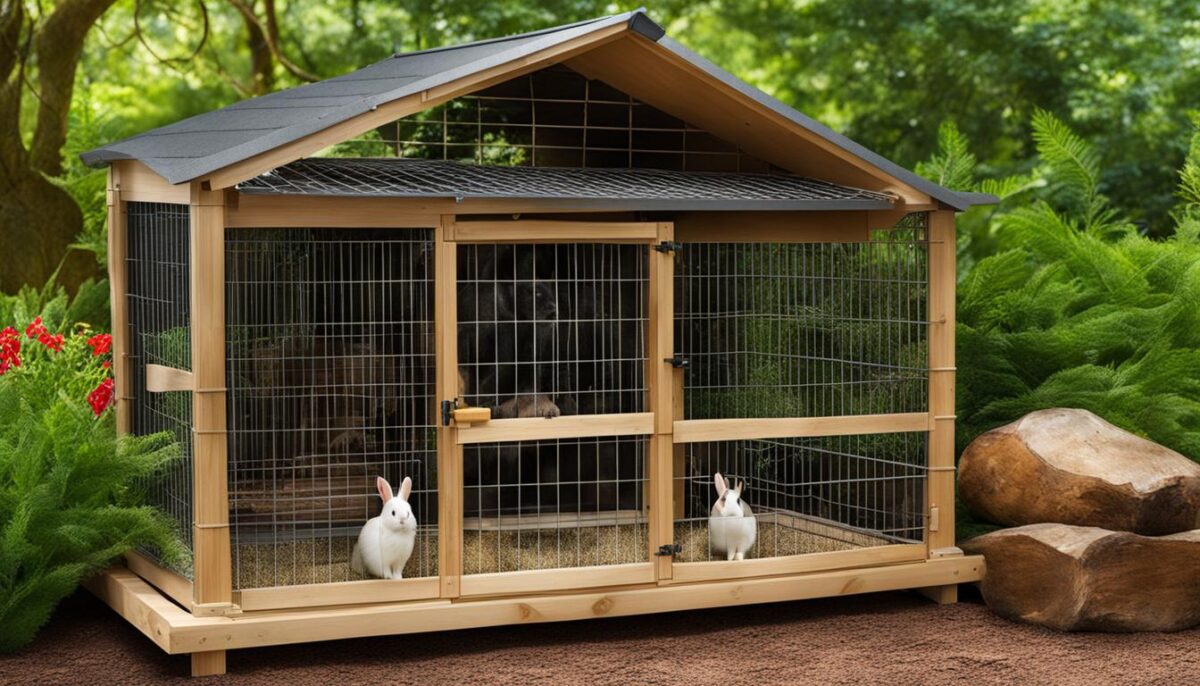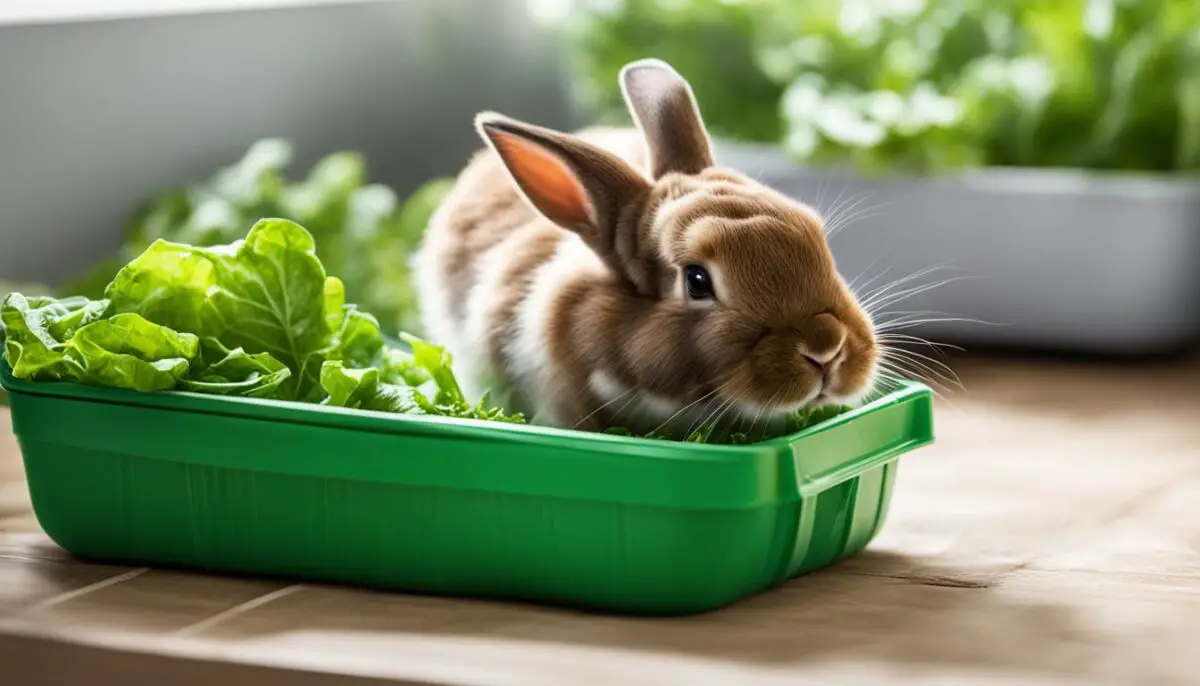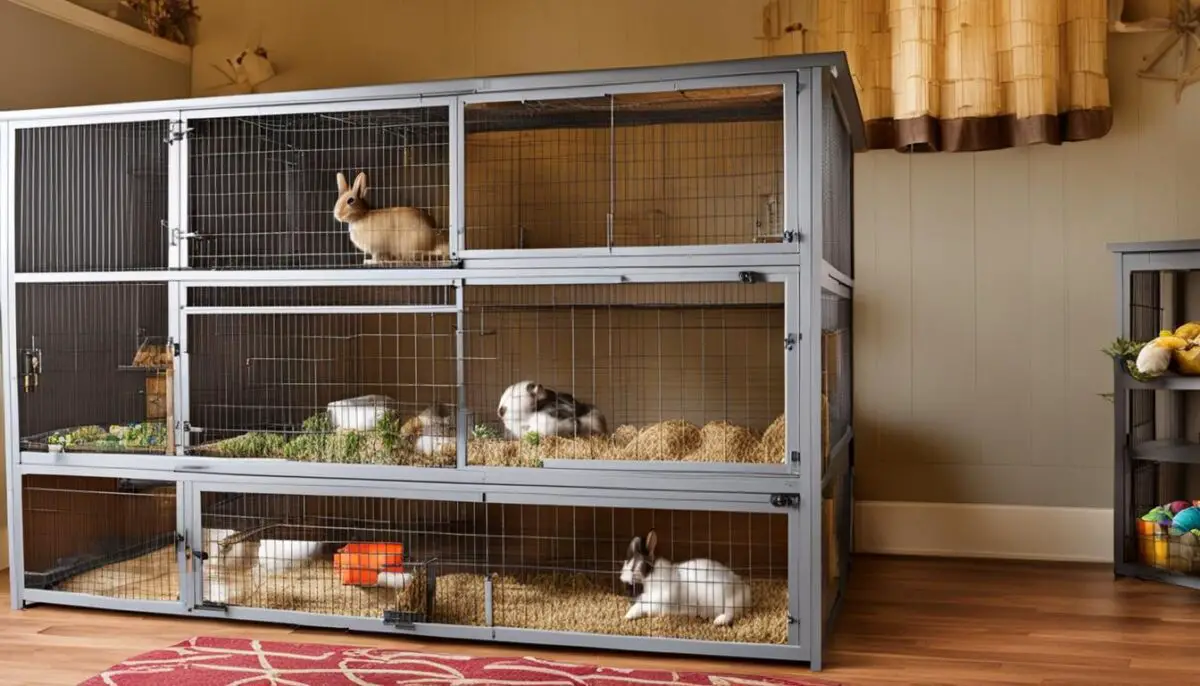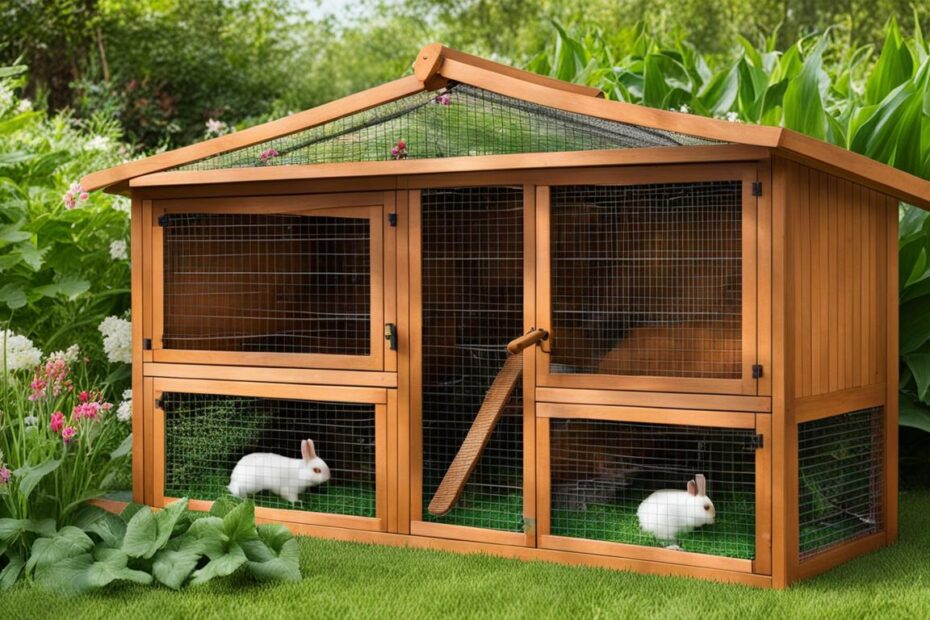Are you considering getting a bunny as a pet? Well, before you do, it’s important to understand the housing needs of these adorable creatures. Bunnies can be housed indoors or outdoors, but they should never be kept completely confined to a cage. In this article, we will be discussing the various options available for providing a spacious, comfortable, and safe living environment for your bunny.
When it comes to housing a bunny indoors, it’s crucial to provide a hutch or crate that allows the bunny to move about freely and stretch out fully. The cage should also have enough space for a litter box, water dish or bottle, food dish, and toys. It’s best to avoid cages with floors that could possibly harm the bunny’s sensitive feet or have slippery surfaces. For larger breeds like Flemish Giants, the cage should be at least four times the size of the bunny, with minimum dimensions of 24″ high, 30″ deep, and 48″ wide.
If you prefer to house your bunny outdoors, it’s essential to protect them from direct sun, wind, rain, and extreme temperatures. The cage should also be secure from potential predators such as dogs, cats, coyotes, and raccoons. Outdoors, the Flemish Giant breed can handle cold temperatures but is sensitive to heat. To ensure their safety and well-being, it’s recommended to provide an additional enclosure around the bunny’s cage to protect against predators.
When taking your bunny outside for supervised visits, be aware of potential dangers such as pesticides on grass, predators, heat stroke, poisonous plants, and bugs. Also, consider litter training your bunny to make these visits more convenient and hygienic. A diet consisting of fresh hay, vegetables, and a good quality rabbit feed is essential for their overall health.
As key takeaways, remember to provide a spacious and comfortable living environment for your bunny, whether indoors or outdoors. Litter training, proper feeding, and regular cage cleaning are crucial for their health and well-being. Lastly, always prioritize the safety and protection of your bunny from potential hazards.
Key Takeaways:
- Choose a spacious cage that allows your bunny to move freely indoors or outdoors.
- Ensure the cage is secure from predators and protected from extreme weather conditions.
- Consider litter training your bunny for easier outdoor visits.
- Provide a balanced diet consisting of fresh hay, vegetables, and quality rabbit feed.
- Regularly clean the cage to maintain cleanliness and prevent odors.
Housing your Bunny Indoors
When it comes to housing your bunny indoors, providing a comfortable and spacious enclosure is essential for their well-being. A suitable rabbit house should allow your bunny to move about freely and stretch out fully. In addition to ample space, it’s important to include essential items such as a litter box, water dish or bottle, food dish, and toys in the enclosure.
To create the perfect indoor rabbit habitat, consider setting up a puppy pen or X-pen in a designated area of your house. This allows your bunny to have their own space while still being part of the family. Some people prefer cages with wire floors, as it allows for easy cleaning with a litter pan placed underneath. However, it’s crucial to include a piece of plywood for your bunny to stand on. This prevents any potential foot damage or discomfort caused by the wire floor.
Regular cleaning is important to maintain your bunny’s health and keep the enclosure fresh. Clean the cage at least once a week using warm water and soap to remove any buildup of urine odor and bacteria.
Indoor Bunny Housing Tips:
- Choose a hutch or crate that provides enough space for your bunny to move around comfortably.
- Include essential items such as a litter box, water dish or bottle, food dish, and toys in the enclosure.
- Avoid cages with slippery floors or floors that may trap your bunny’s feet.
- Consider setting up a puppy pen or X-pen in a specific area of your house to give your bunny their own space.
- If opting for a cage with wire floors, place a piece of plywood for your bunny to stand on.
- Clean the cage at least once a week with warm water and soap to maintain cleanliness and eliminate odor.
Remember, the goal is to provide a safe and comfortable indoor environment for your bunny. With the right housing setup, your furry friend will be able to hop, play, and relax to their heart’s content.

Remember, a happy bunny is a healthy bunny! Providing a spacious and secure outdoor habitat will contribute to your bunny’s overall well-being and happiness.
Trips Outdoors and Rabbit Habits
When it comes to taking your bunny outside for some fresh air and stimulation, it’s important to ensure that the trips are short, structured, and supervised. While outdoor visits can be beneficial for your rabbit’s well-being, there are potential dangers that need to be considered.
Remember, bunnies are curious creatures, and it’s our responsibility to keep them safe during outdoor adventures.
Pesticides used on grass can be harmful to rabbits, so it’s crucial to choose areas that are free from chemical treatments. Additionally, keeping a watchful eye for predators is essential, as rabbits are natural prey animals. Heat stroke can be a serious concern during hot weather, so it’s important to provide shade and ensure that your bunny stays cool.
Another potential danger lies in the presence of poisonous plants and bugs. Some common plants, such as lilies and daffodils, can be toxic to rabbits if ingested. It’s essential to familiarize yourself with common toxic plants and remove them from the areas where your bunny might roam.
To minimize potential risks and encourage good bathroom habits, it’s recommended to litter train your bunny. Placing a litter box in its preferred corner and placing some droppings in it can help your bunny understand where to go. When selecting litter, avoid clumping varieties as rabbits tend to consume some of their droppings.
During outdoor visits, it’s important to ensure that your bunny has access to water at all times. This can be achieved through a water bottle or a water dish, depending on your rabbit’s preferences. Staying properly hydrated is crucial for your bunny’s overall health and well-being.
In terms of feeding, it’s important to provide a well-balanced diet that includes fresh hay, vegetables, and a good quality rabbit feed. Hay should make up the bulk of your bunny’s diet, while vegetables provide essential nutrients. A balanced rabbit feed can supplement these dietary needs. Treats should be given sparingly to avoid weight gain and other health issues.
Rabbit Behavior during Outdoor Visits
When you take your bunny outdoors, you might notice some interesting behaviors. Rabbits may exhibit signs of excitement and curiosity, exploring their surroundings with enthusiasm. They may also display playful behaviors, such as jumping and darting around.
It’s important to remember that each bunny is unique, and their behaviors may vary.
Some rabbits may prefer to stay close to their owners, seeking comfort and reassurance. Others may be more independent, venturing out on their own to explore. Observing and understanding your rabbit’s behavior during outdoor visits can help you tailor the experience to their preferences and ensure a safe and enjoyable time for both of you.
Now, let’s take a look at some common rabbit behaviors and what they might signify:
| Rabbit Behavior | Possible Significance |
|---|---|
| Binkying (Jumping and twisting mid-air) | Expressing joy and happiness |
| Nose twitching | Scent detection and exploration |
| Ear movement | Listening for sounds and assessing the environment |
| Digging | Natural instinct and exploration |
| Running and zooming | Playfulness and exercise |
Understanding your rabbit’s behavior can help you gauge their comfort level and ensure their safety during outdoor visits. It’s important to provide a secure and enriched environment that allows your rabbit to exhibit natural behaviors while staying protected from potential dangers.
As you continue to spend quality time with your bunny outdoors, you’ll develop a stronger bond and gain a deeper understanding of their unique personality and needs.
Litter Training and Feeding your Bunny
Litter training a bunny is an essential aspect of maintaining a clean and hygienic living environment for your furry friend. Fortunately, bunnies have a natural inclination to choose a specific corner inside their hutch for their toilet needs.
Bunnies tend to choose a corner inside their hutch to use as their toilet.
To facilitate litter training, it is important to use a litter that is safe for bunnies. One excellent option is pelleted paper products made from recycled newspaper, which are not only eco-friendly but also provide a comfortable surface for your bunny’s paws.
When it comes to feeding your bunny, providing a balanced and nutritious diet is crucial for its overall well-being. A healthy rabbit diet should include fresh hay, vegetables, and a high-quality rabbit feed.
- Fresh hay: This should form the bulk of your bunny’s diet. For adult bunnies, timothy hay, grass hay, and oat hay are excellent choices. Younger bunnies, such as baby rabbits, can benefit from the nutritional value of alfalfa hay.
- Vegetables: Incorporating a variety of vegetables into your bunny’s diet is important for providing essential vitamins and minerals. Some suitable options include leafy greens like kale, spinach, and romaine lettuce, as well as carrots, celery, and bell peppers. It is advisable to introduce new vegetables gradually to avoid digestive upset.
- Rabbit feed: A good quality rabbit feed that is specifically formulated for bunnies is an important addition to their diet. Look for feeds that contain a balance of essential nutrients and avoid those with added sugar or artificial additives. Consult with a veterinarian to determine the appropriate feed for your bunny’s specific needs.
Treats should be given sparingly to avoid obesity and should only comprise a small portion of your bunny’s overall diet.

Remember, water should be made readily available to your bunny at all times. This can be provided in the form of a water bottle or a water dish, ensuring that your bunny stays properly hydrated.
In summary, litter training your bunny is a simple process that takes advantage of their natural instincts. Using a safe litter and providing a well-rounded diet consisting of hay, vegetables, and a suitable rabbit feed will contribute to your bunny’s health and happiness.
Choosing the Right Cage Material
When it comes to lining a rabbit cage, the choice of material is crucial to ensure the comfort and well-being of your bunny. It is important to avoid using mesh or wire, as they can hurt the sensitive feet of rabbits and potentially lead to infections or sore hocks.
There are several options available for lining a rabbit cage, including:
- Hay: Hay is a popular and natural bedding option for rabbits. It provides insulation, absorbs moisture, and allows for natural digging and foraging behavior. Make sure to use clean, fresh hay and change it regularly to maintain cleanliness.
- Shredded newspaper: Shredded newspaper can be used as a temporary bedding material. However, it should be changed frequently to prevent ink transfer and maintain cleanliness.
- Recycled pulp: Recycled pulp bedding, made from materials such as recycled paper, is an eco-friendly option that provides good absorption and odor control. It needs to be changed less frequently compared to other bedding options.
- Food-grade bedding: Food-grade bedding, such as hemp or aspen shavings, is another safe option for rabbits. It is known for its absorbency and comfort, but it should be used with caution as some rabbits may be sensitive to certain types of wood shavings.
It is important to consider your rabbit’s habits and preferences when arranging items inside the cage. Providing a cozy place, toys, items to chew on, and a hiding spot for the rabbit when it’s scared are all important aspects of creating a comfortable and stimulating environment for your bunny.
Rabbit Cage Material Comparison
| Material | Benefits | Considerations |
|---|---|---|
| Hay | – Provides insulation – Allows for natural digging and foraging behavior – Economical and readily available |
– Requires frequent changing – Can become soiled easily |
| Shredded newspaper | – Temporary bedding option – Easy to source |
– Ink transfer may occur – Requires frequent changing |
| Recycled pulp | – Eco-friendly option – Good absorption and odor control – Less frequent changing required |
– May be more expensive than other options – Availability may vary |
| Food-grade bedding | – Absorbent and comfortable – Some options have good odor control – Can be a safe choice for rabbits |
– Certain types of wood shavings may cause sensitivity – Availability may vary |

An indoor rabbit hutch, commonly known as a rabbit cage, is made of wire and provides a suitable home for rabbits kept indoors. It offers a confined space for your furry friend to relax and play. These cages are usually equipped with all the essential amenities, including a food dish, water bottle, and space for a litter box. Make sure to choose a cage that is spacious enough for your rabbit to move around comfortably.
Rabbit Hutches (Outdoor Rabbit Hutch)
If you prefer to keep your rabbit outdoors, a rabbit hutch is the ideal choice. These are larger than rabbit cages and are elevated off the ground, providing fresh air and protection from predators. A good-quality outdoor rabbit hutch should have a solid roof, proper ventilation, and windows lined with mesh to keep out predators and other potential dangers.
Rabbit Sheds
“Rabbit sheds are spacious enclosures that can accommodate multiple rabbits.”
Rabbit sheds are even larger than rabbit hutches and are designed to house multiple rabbits. These sheds provide ample space for rabbits to move around and engage in natural behaviors. To ensure the comfort and safety of your rabbits, it is important to weatherproof the shed and provide proper ventilation.
Regardless of the type of rabbit home you choose, always prioritize your bunny’s well-being by providing a comfortable and secure living environment.
Conclusion
Providing a comfortable and spacious housing option for your bunny is crucial for its well-being and happiness. Whether you choose an indoor cage, outdoor hutch, or a larger shed, the key is to create an environment that allows your bunny to exercise, eat, sleep, and hide comfortably.
Litter training, proper feeding, and regular cage cleaning are essential for your bunny’s health. By providing a big rabbit cage and following the recommended housing options, you can ensure that your bunny has a safe and secure enclosure to call home.
Remember, each bunny is unique, so consider factors like the bunny’s size and living space preferences when selecting the right housing option. With the proper care and attention, your bunny can thrive and enjoy a happy and fulfilling life in its new rabbit enclosure.
FAQ
What size should a bunny cage be?
When housing a bunny indoors, the cage should be large enough for the bunny to move about freely and stretch out fully. For a Flemish Giant bunny, the cage should be at least four times the size of the bunny, with minimum dimensions of 24″ high, 30″ deep, and 48″ wide.
What should I include in a bunny cage?
A bunny cage should have space for a litter box, water dish or bottle, food dish, and toys. It is best to avoid a crate with a floor that a bunny might get its feet caught in or a slippery floor.
How often should I clean my bunny’s cage?
It is recommended to clean the cage once a week with warm water and soap to maintain the bunny’s health and control urine odor.
How should I protect my outdoor bunny from predators?
When housing a bunny outdoors, it is important to secure the cage from predators such as dogs, cats, coyotes, and raccoons. Providing a second enclosure a foot away from the bunny’s cage can provide additional protection.
What should I use to line a rabbit cage?
It is important to avoid using mesh or wire to line a rabbit cage, as it can hurt the bunny’s feet and cause infections or sore hocks. Hay, shredded newspaper, recycled pulp, and food-grade bedding are common options.
What are the different types of rabbit homes?
There are various types of rabbit homes, including rabbit cages, indoor rabbit hutches, outdoor rabbit hutches, and rabbit sheds. The choice depends on the owner’s preferences and the bunny’s size and living space preferences.
How should I litter train my bunny?
Litter training a bunny is easy. You can place a litter box in its preferred corner and put some droppings in the litter box to encourage its use. Avoid exposing bunnies to clumping litters, as they consume some of their droppings.
What is the best diet for a bunny?
Bunnies should be fed a diet that includes fresh hay, vegetables, and a good quality rabbit feed. Hay should make up the bulk of their diet, and treats should be fed sparingly to avoid obesity.
What are the best materials for a rabbit cage?
It is important to avoid using mesh or wire for a rabbit cage. Hay, shredded newspaper, recycled pulp, and food-grade bedding are common options for lining a rabbit cage.
What are the different types of rabbit homes?
Different types of rabbit homes include rabbit cages, outdoor rabbit hutches, and rabbit sheds, depending on the housing preferences and needs of the bunny and owner.
How can I provide the best housing for my bunny?
To provide the best housing for your bunny, ensure it has enough space for exercise, eating, sleeping, and hiding. Litter training, proper feeding, and regular cleaning of the cage are essential for the bunny’s health and well-being.


